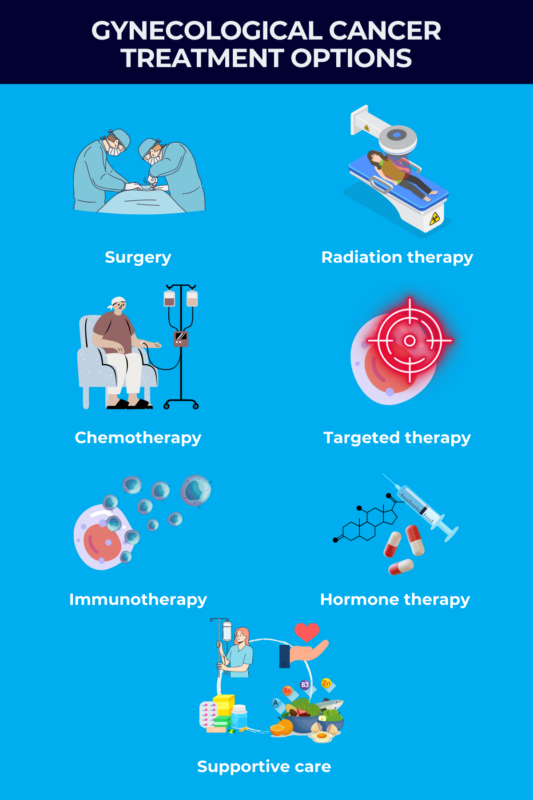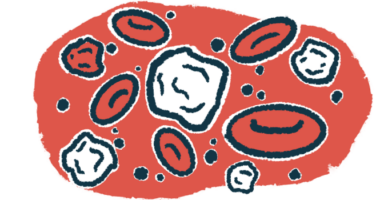Gynecological cancer treatment
Last updated Dec. 18, 2024, by Lindsey Shapiro, PhD

There are several treatment approaches for gynecological cancer, which encompasses all cancers that originate in the female reproductive system.
The choice of treatment will depend on the cancer type, how far it has spread, a patient’s general health status, and other factors, such as whether the patient wishes for their fertility to be preserved.
Often, treatment will involve a combination of different therapies administered simultaneously or sequentially, based on individual circumstances and a patient’s response to, or ability to tolerate, specific treatment methods.
As with all cancers, reaching a diagnosis quickly is important for an early start of treatment, which maximizes the chances that gynecological cancer can be cured before it has spread elsewhere in the body.
Understanding gynecological cancers
Gynecological cancer is an umbrella term for all cancers that start in the female reproductive organs. This broad category includes various types of cancer, each with distinct features and requiring different treatment approaches.
Understanding the type of gynecological cancer involved is essential for developing an adequate treatment plan and improving patient outcomes.
Types of gynecological cancers
There are five main types of gynecological cancer:
- Uterine cancer, which mainly affects postmenopausal women. It includes endometrial cancer, the most common gynecological cancer, and a rarer form called uterine sarcoma.
- Ovarian cancer is generally considered the most deadly gynecological cancer, because its most common type — epithelial ovarian cancer — often is not diagnosed until the cancer has spread. There are several rare ovarian cancers, including ovarian sarcoma and mucinous ovarian cancer.
- Cervical cancer is the only gynecological cancer where most cases have a known cause — infection with the human papillomavirus (HPV), a common sexually transmitted infection. It’s also the only gynecological cancer with a reliable screening test for early detection, called a Pap smear.
- Vaginal cancer, which is rare and often occurs secondary to other cancer types, also is linked to HPV, and it can sometimes be detected with a Pap smear.
- Vulvar cancer, another rare form of gynecological cancer, is the only one that starts in the external parts of the female genitalia.
In addition to these more common types, other forms of gynecological cancer are known. For example, fallopian tube cancer is a form of gynecological cancer with substantial overlap to ovarian cancer, while primary peritoneal carcinoma is a rare cancer that affects cells lining the abdomen and is treated similarly to ovarian cancer.
How cancer type affects treatment
While there is some overlap in the main treatment strategies for gynecological cancers, the specific approach used will vary by cancer type, based on how each cancer tends to respond.
Still, even for people with the same cancer type, the treatment of gynecological cancer can differ based on several factors, including:
- the size of the cancer and whether it has spread
- characteristics of the tumor, including certain DNA mutations
- whether the cancer is newly diagnosed or has returned after treatment
- a patient’s age and desire to have children
- a person’s general health status.
A healthcare team, including a gynecologic oncologist, will work with patients to design a treatment plan that’s optimized for their individual situation.

Surgery
Surgery is the first choice of treatment for most gynecological cancers. One notable exception is vaginal cancer, where surgery is generally only performed in very early stages or when radiation therapy was not curative.
The exact type of surgery performed depends on the cancer type and how far it has spread, but it typically involves removing tumors and any surrounding tissues that may be at risk. Doctors will usually collect tissue samples and have them analyzed to determine the cancer’s stage, and whether other treatments will be needed after the surgery.
In early stages, surgery may completely remove the cancer and cure the patient. In later stages, surgery is not likely to be curative, but it might still be used to remove as much cancer as possible to slow its spread and ease symptoms.
Most surgeries for gynecological cancer are major and invasive procedures, and it can take up to a few months to fully recover. Before surgery, a doctor will make sure a person is generally healthy enough to tolerate the operation and to explain potential risks and complications.
Hysterectomy and oophorectomy
Surgery to completely remove the uterus and cervix is called a simple or total hysterectomy. When other nearby tissues and part of the vagina are removed, it’s a radical hysterectomy. Removal of both ovaries and the fallopian tubes is a separate surgery called a bilateral salpingo-oophorectomy (BSO).
Simple or radical hysterectomy combined with BSO is the main uterine cancer treatment and ovarian cancer treatment. A simple or radical hysterectomy, with or without BSO, might also be used in some cases as a cervical cancer treatment or as a vaginal cancer treatment.
There are some variations to the procedure depending on an individual’s case. For example, a doctor might also remove the sheet of fatty tissue in the abdomen called the omentum, especially for a type of uterine cancer called serous carcinoma.
Depending on the tissues that need to be removed, the surgery may be performed by cutting open the abdomen or through the vagina. A doctor will probably remove nearby lymph nodes as well, or take samples of other tissues and have them sent to the lab for testing. This will help in understanding if the cancer has spread.
Removing the ovaries will bring about menopause. In some cases, it might be possible for the surgeon to preserve one or both ovaries. This may increase the chances that the cancer will return, but is not thought to negatively influence survival.
Loss of the uterus, however, means that a woman will never be able to carry a child. Some people with early-stage uterine cancer may be able to receive other treatments and delay surgery, allowing them time to give birth. Still, surgery is usually recommended after childbearing or if the cancer spreads.
Other surgeries
Another cervical cancer treatment that can help preserve fertility is called a radical trachelectomy, where the upper part of the vagina and the cervix are removed, but the main part of the uterus remains intact.
Removal of all or part of the vagina — a vaginectomy — is used for some early-stage vaginal cancers, while a vulvectomy, the partial or total removal of the vulva, can be considered for vulvar cancer. Either of these procedures may be followed by reconstructive surgery to rebuild a vagina or vulva.
For some types of vaginal, vulvar, or cervical precancers or very early-stage cancers, a few procedures might be performed to remove the small amount of affected tissue without a major surgery. These include:
- laser surgery, where a focused laser beam is used to kill abnormal cells
- cryoablation, where cancer cells are killed with a very cold metal probe
- excisional surgery, where only the cancerous tissue and a very small amount of healthy tissue around it are cut out.
Surgery for advanced or returning cancer
In advanced gynecological cancers that have spread to other tissues, surgery might still be performed to remove as much of the tumor as possible. Called debulking surgery, it can help ease symptoms and slow the cancer’s growth, helping other treatments to work better.
In certain cases of cervical, vaginal, or vulvar cancers that have returned after treatment and spread within the pelvis, a major surgery called pelvic exenteration might be performed if a surgeon believes it will be curative.
This surgery takes out everything that would be removed with a radical hysterectomy and oophorectomy, as well as other tissues where the cancer has spread, which may include the vagina, bladder, rectum, parts of the intestines, and lymph nodes. If the bladder and/or rectum are removed, a person will need a small, and lifelong, opening in the abdomen to collect their urine (urostomy) or stools (colostomy).
Radiation therapy
Radiation therapy, or radiotherapy, uses focused beams of radiation, usually from X-rays, to kill cancer cells. It is often used as a first-line vaginal cancer treatment. For other gynecological cancers, radiation therapy may be used:
- when surgery is not possible
- to shrink the cancer before surgery
- to kill the remaining cancer cells or prevent cancer from coming back after surgery.
Two main types of radiotherapy are used for gynecological cancers. The type that’s used will depend on the cancer’s form and radiotherapy’s purpose:
- External beam radiation therapy focuses radiation toward a tumor from outside the body.
- Internal radiation therapy, or brachytherapy, involves placing radioactive materials inside the body, as close to the cancer as possible, to allow higher doses of more focused treatment.
Radiation therapy is usually delivered as a course of short sessions over several days or weeks, and it is often given alongside chemotherapy.
Side effects will vary depending on the type of radiation used and where it was focused, but some common short-term radiotherapy side effects may include:
- fatigue
- upset stomach or diarrhea
- skin changes
- irritation to the bladder, rectum, or vagina
- low blood counts.
Some longer-term radiotherapy risks include:
- damage to the ovaries, leading to premature menopause
- weakened bones
- lymphedema, or swelling due to fluid retention
- vaginal dryness and narrowing, which can make vaginal sex painful
- bladder or bowel problems.
Chemotherapy
Chemotherapy is a large class of medications that work in various ways to stop cancer cells from growing. They may be used with any form of gynecological cancer, sometimes in combination with radiotherapy, for various purposes:
- to shrink the tumor before surgery
- to slow cancer growth and ease symptoms when surgery is not possible
- to prevent cancer from coming back (recurrence) after surgery
- for treating recurrent cancer.
Many different chemotherapy medications exist, and are used alone or in combination to treat gynecological cancers. The choice of chemotherapy will depend on a number of factors, including the cancer type and a person’s health status. A few of the commonly used chemotherapies include:
- cisplatin
- carboplatin
- paclitaxel (sold as Abraxane, generics available)
- docetaxel (sold as Taxotere, among others).
Chemotherapy for gynecological cancer is usually taken orally or infused into the bloodstream. In some ovarian cancer cases, chemotherapy may be injected directly into the abdominal cavity — this is called intraperitoneal chemotherapy and allows a higher dose of the chemotherapy medication to reach the tumor.
Topical chemotherapy that’s put directly on the skin, particularly an agent called fluorouracil, might be used to treat vaginal and vulvar precancers, or lesions that if left untreated have the potential to develop into cancer. It may be given with another topical medication called imiquimod to boost the immune system’s response to abnormal cells.
Chemotherapy is very effective at killing cancer cells, but it also damages healthy cells in the body, leading to a wide range of side effects. Chemotherapy side effects and chemotherapy risks vary depending on the specific medication used. Possible chemotherapy side effects include:
- fatigue
- hair loss
- skin changes
- nausea, vomiting, and loss of appetite
- changes in bowel habits
- a weakened immune system
- easy bruising or bleeding
- abnormal sensations or pain related to nerve damage (neuropathy)
- mouth or vaginal sores
- changes in menstrual cycle and premature menopause
- fertility impairment.
Other therapies
Other specialized types of medications are sometimes used to treat gynecological cancers, usually when the cancer is more high risk or has come back after initial treatments. These therapies usually are not part of vulvar cancer treatment.
Targeted therapies
Targeted therapies are designed to specifically target changes in cancer cells, which these cells use to survive and replicate quickly. Because these therapies hone in on cancer cells and leave healthy cells mostly unharmed, their side effect profile is different, and sometimes less severe, than standard chemotherapy.
To be eligible for a targeted therapy, however, a person’s cancer cells usually have to be tested in the lab to make sure they have the specific feature that is targeted by the medication.
Several different classes of targeted therapies are used for gynecological cancers. They typically are given as intravenous (into-the-vein) infusions or oral capsules, and include:
- kinase inhibitors, such as lenvatinib (sold as Lenvima, generics available)
- angiogenesis inhibitors, such as bevacizumab (sold as Avastin, among others)
- mTOR inhibitors, such as everolimus (sold as Afinitor, among others) or temsirolimus (sold as Torisel, generics available)
- antibody-drug conjugates, such as Enhertu (fam-trastuzumab deruxtecan), Tivdak (tisotumab vedotin-tftv), or Elahere (mirvetuximab soravtansine)
- RET inhibitors, such as Retevmo (selpercatinib)
- NTRK inhibitors, such as Vitrakvi (larotrectinib) or Rozlytrek (entrectinib)
- PARP inhibitors, such as Lynparza (olaparib), Rubraca (rucaparib) or Zejula (niraparib).
Compared with chemotherapy, targeted therapies often result in milder side effects, which can include:
- diarrhea
- fatigue
- hair loss
- joint or muscle pain
- loss of appetite
- nausea and vomiting
- high blood pressure
- low blood cell counts.
Immunotherapy
Immunotherapy is a related class of medications designed to boost the immune system’s ability to target and kill cancer cells. The specific immunotherapies that can be used in some gynecological cancers are called immune checkpoint inhibitors, and all target a protein on immune cells called PD-1. These include:
- Keytruda (pembrolizumab)
- Opdivo (nivolumab)
- Libtayo (cemiplimab-rwlc)
- Jemperli (dostarlimab-gxly).
Possible side effects of immunotherapy include:
- fever
- itching
- nausea and loss of appetite
- cough
- muscle or joint pain
- feeling tired or weak
- autoimmune reactions.
Hormone therapy
Hormones can stimulate the growth of some gynecological cancers. Hormone therapy, used most often used as an advanced endometrial cancer treatment and in some types of ovarian cancer, modulates hormone levels or activity to help slow cancer growth.
Usually administered by injection or as pills, hormone therapy may be given to treat cancer that’s advanced or recurrent, or to delay the need for surgery in women who wish to have children. Types of hormone therapy include:
- progestins, including medroxyprogesterone acetate (sold as Provera, among others) and megestrol acetate (sold as Megace ES, generics available)
- tamoxifen (sold as Soltamox, generics available)
- luteinizing hormone-releasing agonists, including leuprolide (sold as Eligard Kit, among others) and Zoladex (goserelin)
- aromatase inhibitors, such as letrozole (sold as Femara, generics available), exemestane (sold as Aromasin, generics available), or anastrozole (sold as Arimidex, generics available).
Treatment with hormone therapy also can result in side effects, such as:
- symptoms of menopause, like hot flashes and vaginal dryness
- tiredness
- reduced libido
- weight gain
- muscle and joint pain
- bone thinning or osteoporosis, when taken for a long time.
Supportive therapies and lifestyle changes
Gynecological cancer and its treatments can cause a wide range of symptoms and side effects that interfere with a person’s daily life. Supportive care, also known as palliative care, is a critical component of gynecological cancer treatment. It focuses on minimizing discomfort and maximizing quality of life for patients at any stage of disease, so that they can live as well as possible.
Supportive therapy for gynecological cancer patients may include:
- medications to manage nausea and vomiting, or to stimulate appetite
- treatments for constipation or diarrhea
- a pain management plan, including medications, heating or cooling, or massage
- nutritional support
- physical therapy, including pelvic floor therapy to strengthen the muscles in the pelvic area.
A palliative care team can also make recommendations about lifestyle changes, including diet and exercise, that might be beneficial for patients based on where they are in their cancer journey.
Living with gynecological cancer can take a toll on a person’s emotional well-being. Managing mental health is an important aspect of gynecological cancer care. A palliative care team also can help people connect with mental health and coping resources, including counseling or support groups.
There are always ongoing clinical studies to test new treatment options or treatment combinations for cancer, and participation could give patients access to therapies that wouldn’t otherwise be available. Those who are interested should ask their doctors if there are any open clinical trials for which they might be eligible.
Treatment for advanced or terminal gynecological cancers
When cancer reaches advanced stages, it may become incurable. Even after treatment for gynecological cancer, there’s a possibility the cancer might return or progress. This can happen following an initial positive response, or due to a treatment becoming less effective over time.
Treatment at this point is focused on keeping the cancer at bay for as long as possible, and making sure that patients remain comfortable.
Depending on where the cancer is and a patient’s own preferences, treatments such as surgery, radiation, chemotherapy, or targeted therapies might be used to slow an advanced cancer’s growth as much as possible. This can help prolong life and ease cancer-related symptoms.
Palliative care to maximize a patient’s comfort is critical at this stage. Patients can work with their doctors to make sure they receive supportive therapies needed to minimize treatment side effects and reduce pain or discomfort.
For those with a terminal cancer diagnosis, there may come a time where a decision is made to stop treatment. Patients at this point may benefit from hospice care, an interdisciplinary approach focused on making people as physically comfortable as possible, while also providing emotional and spiritual support.
Rare Cancer News is strictly a news and information website about the disease. It does not provide medical advice, diagnosis, or treatment. This content is not intended to be a substitute for professional medical advice, diagnosis, or treatment. Always seek the advice of your physician or other qualified health provider with any questions you may have regarding a medical condition. Never disregard professional medical advice or delay in seeking it because of something you have read on this website.
Recent Posts
- The holidays can amplify loneliness for those of us with cancer
- FDA backs faster development of new therapy for hard-to-treat AML
- Elicio’s cancer vaccine triggers broad anti-tumor immunity
- Building a fortress of quiet: How I protect my energy as a caregiver
- Combo treatment may offer new hope to astrocytoma patients: Trial
Related articles






